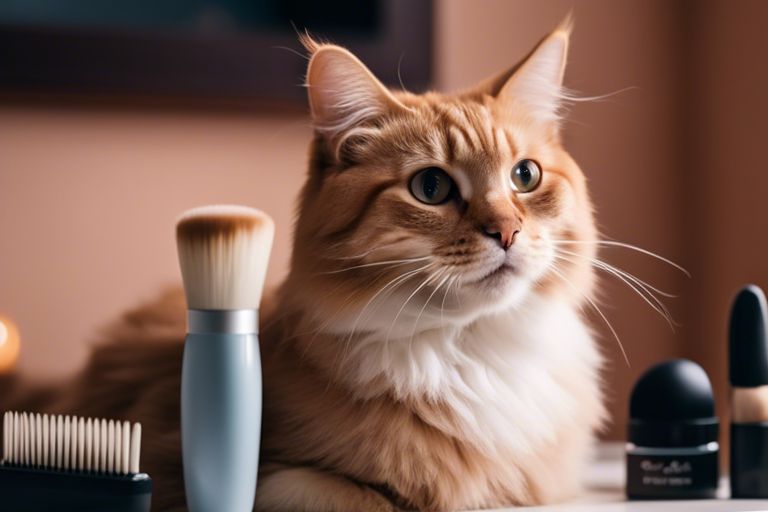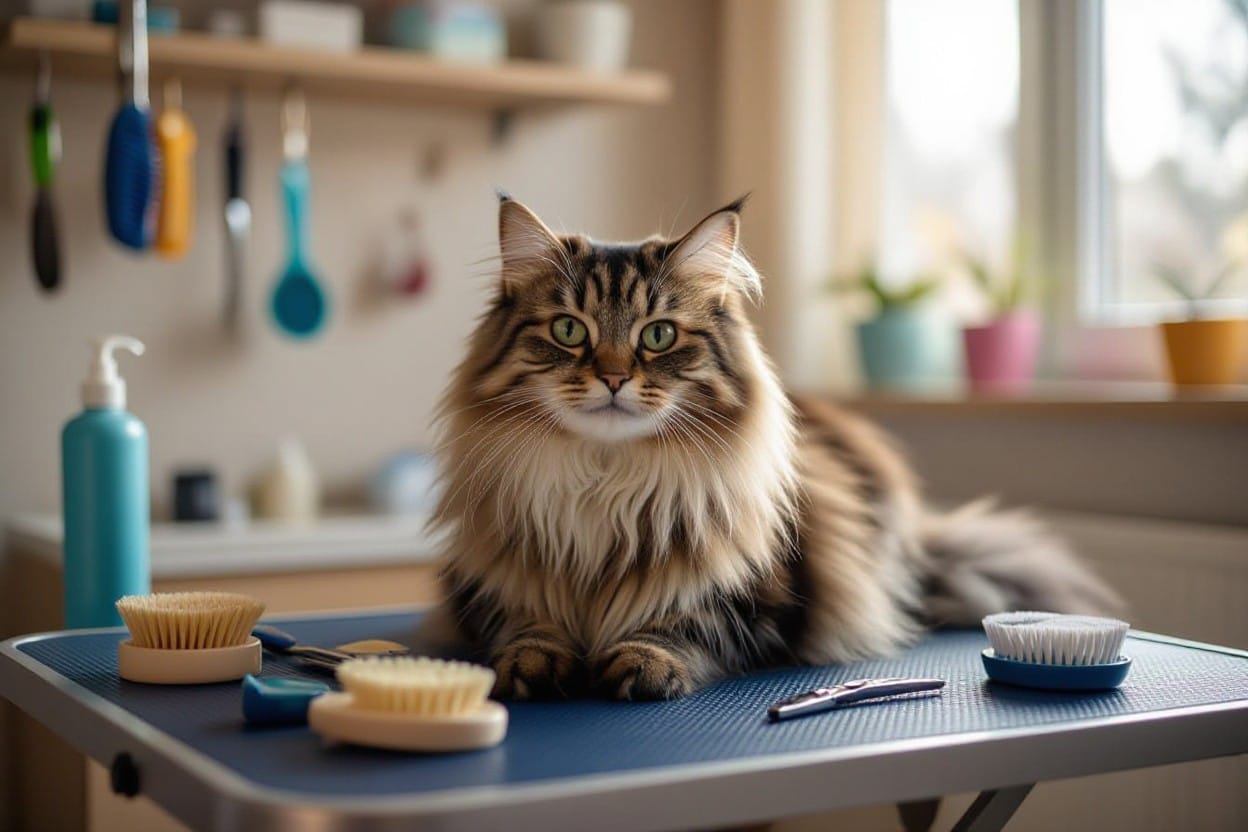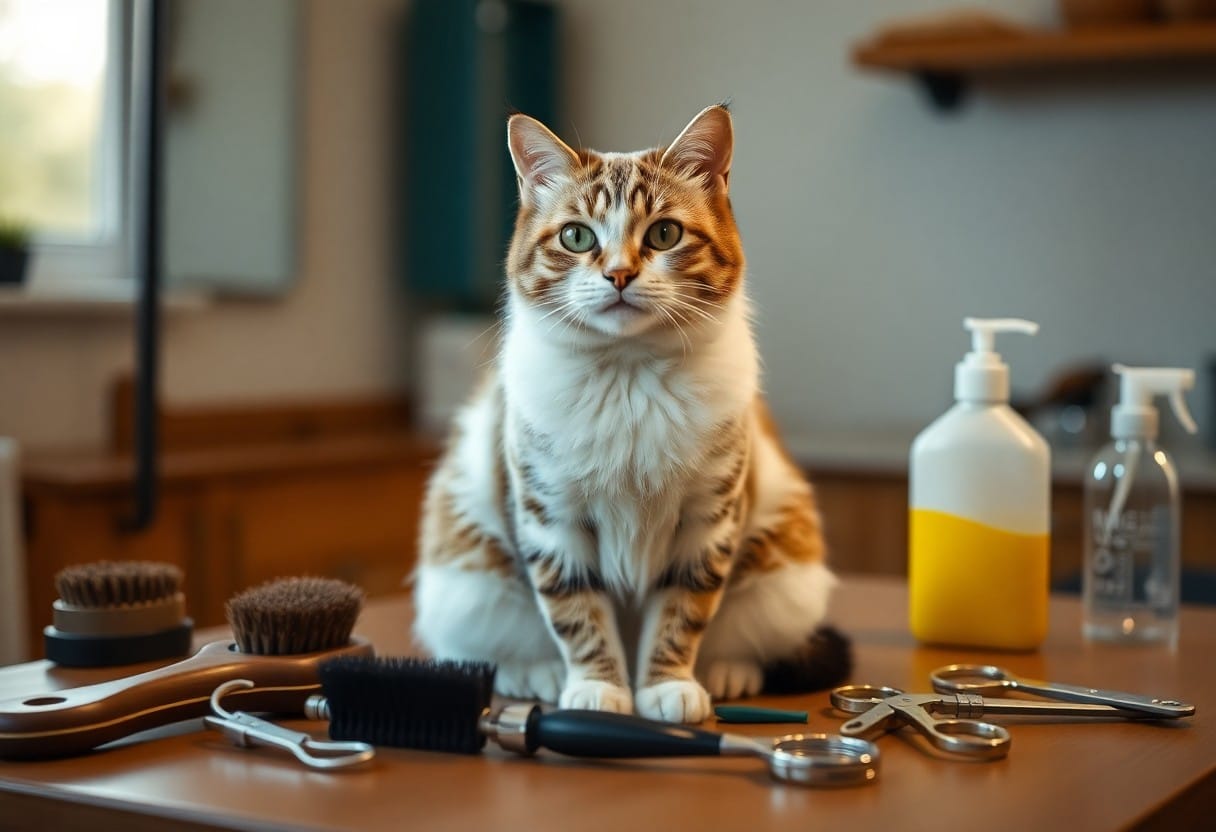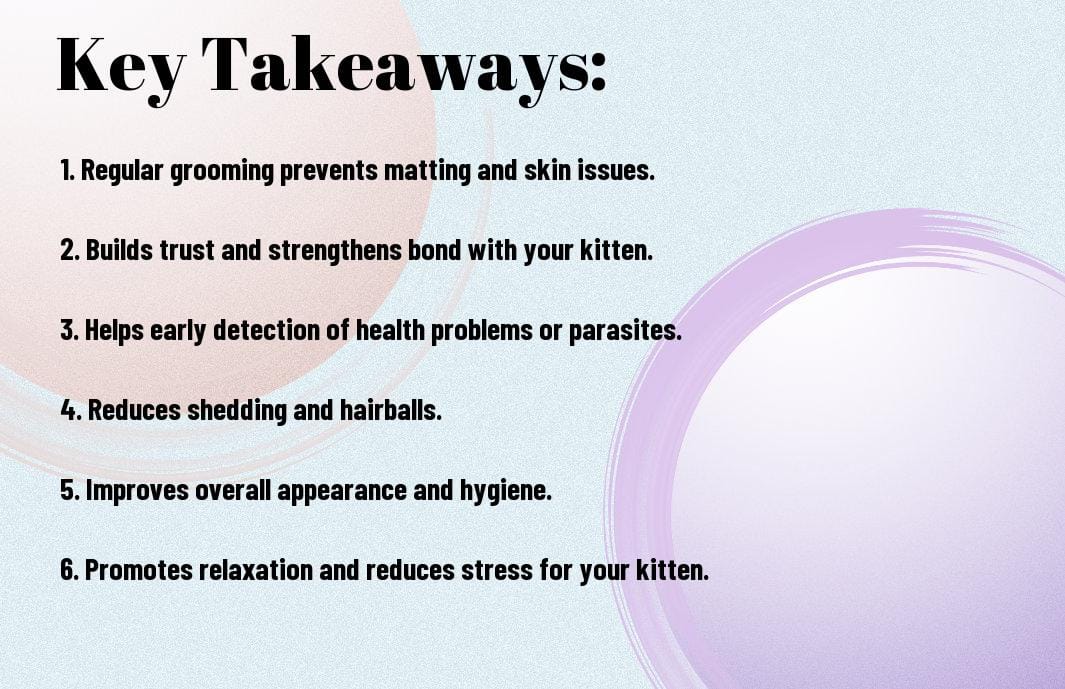Pet grooming is an vital aspect of keeping your feline friend healthy and happy. Regular grooming not only helps to maintain your cat’s physical appearance but also promotes their overall well-being. From reducing shedding to preventing matting and improving circulation, there are numerous benefits to incorporating a grooming routine into your cat’s care regimen.
By understanding the importance of regular cat grooming, pet owners can ensure that their beloved companions not only look their best but also feel their best. In this blog post, we will explore the various advantages of regular grooming for cats and provide tips on how to make the grooming experience a positive one for both you and your furry friend.
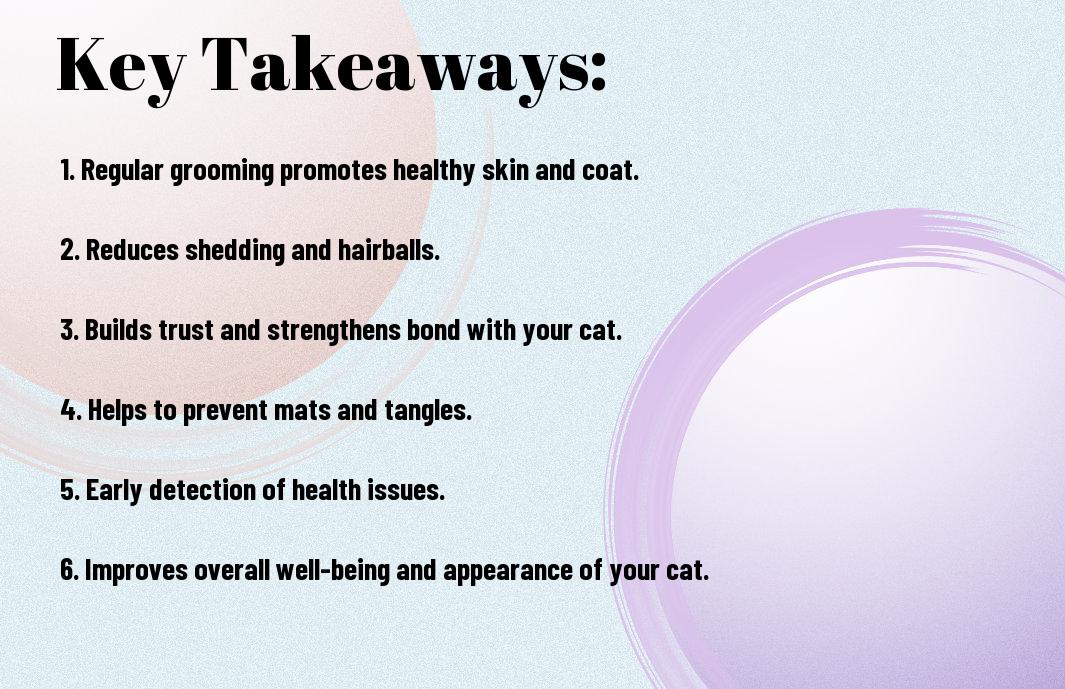
Establishing a Grooming Routine
How Often to Groom Your Cat
Even though cats are meticulous groomers themselves, it is still important for pet owners to establish a regular grooming routine for their feline friends. The frequency of grooming sessions will depend on the length and type of your cat’s coat. Long-haired cats may require grooming every day to prevent matting and tangles, while short-haired cats can typically be groomed a few times a week to keep their coat healthy and shiny.
Best Times of Day for Grooming Sessions
Any cat owner knows that choosing the right time for grooming can make a significant difference in the success of the session. Cats are more likely to be relaxed and receptive to grooming during quiet times of the day when they are naturally more calm, such as after a meal or a nap. Avoid choosing times when your cat is typically active or playful, as they may be less cooperative during these periods.
Grooming your cat in the evening can also be beneficial, as it can help your cat relax and wind down before bedtime. This can create a soothing routine that helps in strengthening the bond between you and your furry companion.
Types of Cat Grooming
There’s a variety of grooming techniques that can help keep your cat looking healthy and happy. Different grooming activities offer various benefits, from reducing shedding to preventing matting and maintaining overall cleanliness. Understanding the different types of grooming can help you create a grooming routine that fits your cat’s needs.
| Brushing and Combing | Bathing: Pros and Cons |
| Nail Trimming Essentials | Ear and Eye Care |
Grooming: Brushing and Combing
Regular brushing and combing help to remove loose fur, prevent mats, and distribute natural oils throughout your cat’s coat. Short-haired cats may benefit from weekly grooming sessions, while long-haired breeds may require daily brushing to prevent tangles and matting.
After a grooming session with brushing and combing, your cat’s coat will look healthier and shinier, and you’ll reduce the risk of hairballs during grooming.
Bathing: Pros and Cons
Types of bathing: Pros and Cons.
ProsCons
| Cleanliness | Stress |
| Healthy skin | Dry skin |
| Odor control | Fear |
| Parasite prevention | Allergic reactions |
Nail Trimming Essentials
An necessary part of cat grooming is nail trimming. Regular nail trims help prevent overgrowth, ingrown nails, and potential scratching injuries. Clippers designed for cats and proper technique are necessary for a safe and effective nail trimming session.
An overgrown nail can curl into your cat’s paw pad, causing pain and infection. By incorporating nail trimming into your grooming routine, you can keep your cat’s nails at a healthy length and prevent any discomfort.
Ear and Eye Care
Nail trimming during ear and eye care is important. Regular cleaning of ears and eyes can help prevent infections and catch any issues early. Maintenance of these areas not only contributes to your cat’s overall hygiene but also allows you to monitor their health more closely.
The correct cleaning techniques and products are necessary for ear and eye care. Consult your veterinarian for guidance on how to properly clean and maintain these sensitive areas.
Grooming Tools and Supplies
Selecting the Right Brushes and Combs
Not all brushes and combs are created equal when it comes to grooming your cat. To ensure that you are selecting the right brushes and combs for your feline friend, consider the coat length and texture of your cat. For long-haired cats, a wide-tooth comb and a slicker brush can help prevent mats and tangles. Short-haired cats may benefit from a soft bristle brush to remove loose fur and debris.
Shampoo and Conditioner for Cats
Grooming your cat with the right shampoo and conditioner can help maintain a healthy coat and skin. This is especially important for cats with skin sensitivities or allergies. Look for a gentle, cat-specific shampoo that is free of harsh chemicals and follow up with a moisturizing conditioner to keep your cat’s coat shiny and soft.
Clippers, Scissors, and Nail Trimmers
On top of brushes and combs, having clippers, scissors, and nail trimmers in your grooming kit can help keep your cat looking neat and tidy. Regularly trimming your cat’s nails can prevent them from becoming overgrown and causing discomfort. Clippers and scissors can also be used to trim fur around the eyes, ears, and paws to prevent mats and ensure good hygiene.
Grooming Wipes and Eye Care Products
Tools like grooming wipes and eye care products can be handy for quick touch-ups and maintaining your cat’s overall hygiene. Grooming wipes are great for freshening up your cat between baths and can help remove dirt and debris from their coat. Eye care products specifically made for cats can help prevent tear stains and keep their eyes clean and healthy.
Nail care is vital for cats, and investing in a good pair of nail trimmers can make the process easier and less stressful for both you and your feline friend. Regular nail trims can also help prevent your cat from scratching furniture and people. Remember to have styptic powder on hand in case you accidentally cut the quick while trimming your cat’s nails.
Health Benefits of Regular Grooming
Skin and Coat Health
The skin and coat of a cat play a vital role in their overall health and well-being. Regular grooming helps to distribute natural oils throughout the fur, keeping it healthy and shiny. It also allows you to look for any abnormalities such as dry patches, irritations, or signs of flea infestations early on.
Preventing Matting and Reducing Hairballs
On top of keeping your cat looking neat and tidy, regular grooming can prevent painful matting of the fur. Matting can lead to skin irritations and infections if left untreated. Additionally, grooming helps to reduce the amount of loose hair that a cat ingests while grooming themselves, which in turn reduces the formation of hairballs.
Regular brushing, especially for long-haired breeds, can help remove loose fur and prevent it from accumulating into hairballs. This can alleviate discomfort for your cat and save them from potential health issues associated with frequent hairball vomiting.
Early Detection of Health Issues
An crucial benefit of regular grooming is the opportunity to detect health issues early. By examining your cat’s skin, coat, eyes, ears, and teeth regularly, you can spot any changes or abnormalities promptly. This can include lumps, bumps, parasites, dental problems, or signs of allergies. Early detection can lead to prompt veterinary care and better outcomes for your feline friend.
Health issues that are caught in their early stages are often easier and less expensive to treat. Regular grooming not only keeps your cat looking their best but also serves as a proactive way to monitor and maintain their health.
Controlling Fleas and Parasites
Fleas and parasites can wreak havoc on your cat’s health if left unchecked. Regular grooming is an effective way to keep these pests at bay. By running a fine-tooth comb through your cat’s fur and checking for any signs of fleas or parasites, you can take action before an infestation occurs. Additionally, grooming allows you to inspect for any flea dirt or eggs, which are early indicators of an issue.
Early intervention in the form of grooming can help control flea and parasite populations before they become a significant problem. This not only protects your cat but also prevents these pests from infesting your home and potentially affecting other pets or family members.
Behavioral Benefits
Reducing Stress and Anxiety
Anxiety in cats can manifest in various ways, including excessive grooming, hiding, aggression, or excessive meowing. Regular grooming sessions can help reduce your cat’s stress and anxiety levels. The calming effect of grooming can help your cat feel more relaxed and secure, leading to a happier feline companion.
Strengthening the Bond Between You and Your Cat
On top of maintaining your cat’s physical health, regular grooming sessions can also strengthen the bond between you and your pet. Cats are grooming each other as a sign of affection and bonding. By mimicking this behavior and providing your cat with gentle grooming, you are reinforcing your relationship and trust with your furry friend.
Between the soothing strokes and gentle touch during grooming, your cat will come to associate these positive interactions with your presence. This can lead to a deeper emotional connection and a more harmonious relationship between you and your cat.
How Grooming Affects Feline Social Behavior
With regular grooming, your cat will not only enjoy a clean and healthy coat but also benefit socially. Cats are social creatures that rely on grooming as a form of social bonding. By grooming your cat regularly, you are not only helping them look their best but also promoting positive social behaviors within your cat’s social group.
Grooming your cat can also help you detect any changes in their behavior or health early on. By spending this quality time together, you are more likely to notice any signs of discomfort, illness, or stress, allowing you to address these issues promptly.
Grooming Tips for Different Cat Breeds
Short-haired versus Long-haired Breeds
Despite their differences in fur length, both short-haired and long-haired cat breeds require regular grooming to maintain their coat’s health and shine. Short-haired breeds like the Siamese or Bengal typically need less grooming compared to long-haired breeds such as the Persian or Maine Coon.
- Short-haired breeds may benefit from a weekly brushing to remove loose hair and prevent shedding.
- Long-haired breeds may require daily brushing to prevent matting and tangles in their fur.
The key to grooming these different breeds lies in understanding their specific needs and dedicating the appropriate amount of time and care to keep their coats in top condition.
Breed-specific Grooming Needs
The grooming needs of a cat can vary significantly based on its breed. Certain breeds, like the Sphynx or Cornish Rex, may require more frequent baths due to their lack of a fur coat. On the other hand, breeds with double coats, such as the Norwegian Forest Cat or Ragdoll, may need extra attention to prevent matting and hairballs.
This level of understanding is critical in providing tailored grooming care that meets the unique requirements of each breed. It ensures that your cat’s grooming routine is both effective and beneficial for their overall well-being.
Grooming Senior Cats and Kittens
An important aspect of cat grooming is adapting to the specific needs of senior cats and kittens. Senior cats may have mobility issues that make self-grooming challenging, requiring assistance with brushing and hygiene maintenance. On the other hand, kittens are still learning grooming behaviors and may need gentle guidance to develop proper grooming habits.
Breedspecific understanding of the aging process can help in adjusting grooming methods and frequency to accommodate the changing needs of senior cats and kittens. This ensures that they receive the necessary care and attention to lead happy and healthy lives.
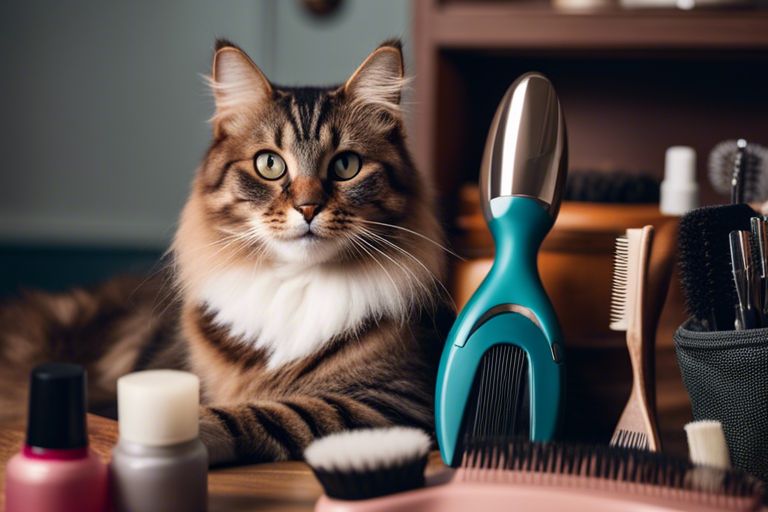
Professional Grooming Services
When to Consider Professional Grooming
One of the best times to consider professional grooming for your cat is when you notice mats in their fur that are difficult to remove or if your cat has a long coat that is prone to matting. Additionally, if your cat becomes anxious or aggressive during grooming sessions at home, it may be beneficial to seek the expertise of a professional groomer who can handle the situation with care and skill.
What to Expect from a Professional Groomer
Grooming your cat professionally involves more than just a simple bath and brush. A professional groomer is trained to handle various grooming tasks such as nail trimming, ear cleaning, and even specialized grooming styles based on your cat’s breed. They also have the proper tools and techniques to ensure your cat’s comfort and safety throughout the grooming process.
It is important to communicate your expectations and any specific concerns you may have about your cat’s grooming needs with the professional groomer. This will help them tailor the grooming session to meet both your cat’s requirements and your preferences as a pet owner.
How to Choose the Right Groomer for Your Cat
For optimal results, when selecting a professional groomer for your cat, it is advisable to look for someone who has experience working with cats specifically. Additionally, consider asking for recommendations from other cat owners or your veterinarian to ensure you choose a reputable groomer that provides high-quality services.
Plus, it is important to visit the grooming facility beforehand to assess the cleanliness, organization, and overall environment to ensure your cat will be comfortable and well taken care of during their grooming appointment.
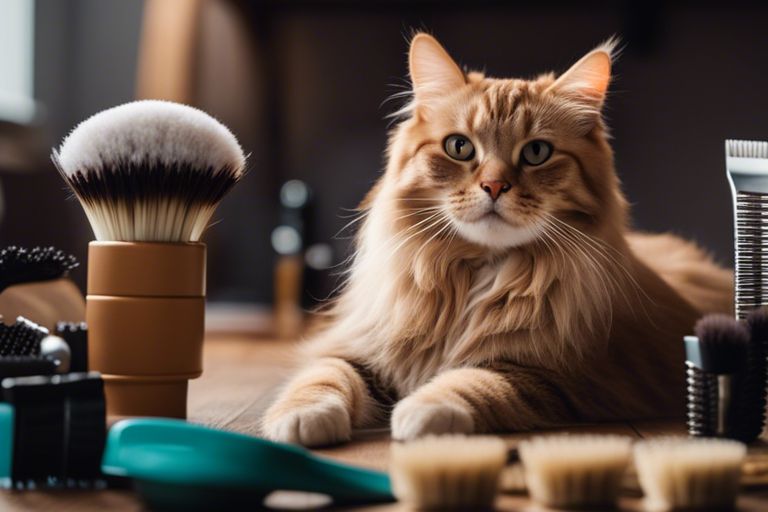
Addressing Common Grooming Challenges
Dealing with Aggressive or Nervous Cats
Many cat owners may face challenges when grooming their feline friends, especially if the cat is aggressive or nervous during grooming sessions. With patience and a gentle approach, it is possible to help your cat become more comfortable with the grooming process over time.
Removing Tangles and Dealing with Mats
With regular grooming, you can prevent tangles from turning into painful mats that can cause discomfort to your cat. It is important to use the right tools such as a comb or a dematting tool to carefully remove any tangles or mats without causing any pain to your cat.
This can be a time-consuming process, but it is crucial for your cat’s well-being. If the mats are too severe or close to the skin, it may be best to seek assistance from a professional groomer to prevent any accidental injuries while trying to remove them.
Grooming Cats with Health Conditions
Challenges may arise when grooming cats with health conditions such as arthritis, skin allergies, or other medical issues. It is vital to take extra precautions and seek advice from a veterinarian before attempting to groom a cat with underlying health problems.
Cats with health conditions may require specialized grooming techniques or grooming products to ensure their comfort and safety during the grooming process. Always prioritize your cat’s health and well-being when grooming, and consult with a professional if needed.
Conclusion
Now, it is evident that regular cat grooming provides numerous benefits for both the cat and their owner. From maintaining a clean and healthy coat to preventing health issues and strengthening the bond between the cat and their owner, the importance of grooming should not be underestimated. By incorporating grooming into your cat care routine, you can ensure your feline companion’s well-being and happiness.
Be mindful of, grooming is not just about aesthetics but also plays a crucial role in your cat’s overall health. Investing time and effort into regular grooming sessions can lead to a healthier and happier cat, creating a stronger connection between you and your beloved pet. So, make grooming a priority in your cat care regimen and reap the rewards of a well-maintained and contented feline friend.
FAQ
Q: Why is regular grooming important for cats?
A: Regular grooming is important for cats as it helps in preventing matting, reducing shedding, promoting healthy skin and coat, and preventing hairballs.
Q: How often should I groom my cat?
A: The frequency of grooming can vary depending on the breed of your cat, but in general, cats should be groomed at least once a week, if not more frequently.
Q: What are the benefits of grooming my cat at home?
A: Grooming your cat at home helps in strengthening your bond with your pet, allows you to monitor their health, and saves money on professional grooming services.
Q: What tools do I need for grooming my cat?
A: Some imperative grooming tools for cats include a slicker brush, a comb, nail clippers, pet-safe shampoo, and a grooming glove or mitt for gentle brushing.
Q: How can I make grooming a positive experience for my cat?
A: To make grooming a positive experience for your cat, introduce them to grooming gradually, use positive reinforcement such as treats, and be gentle and patient during the grooming process.
